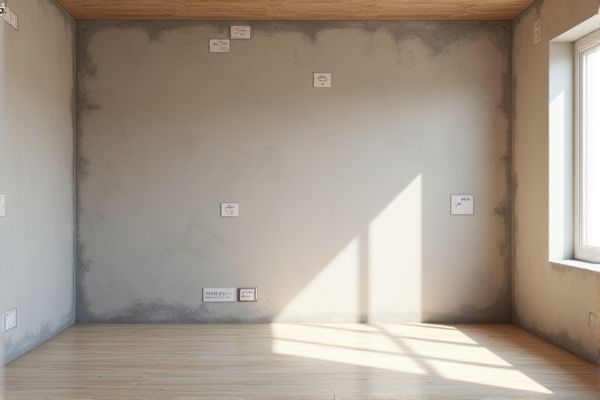
Choosing between drywall and wall paneling for your basement involves considering factors like moisture resistance, durability, and aesthetic appeal; drywall offers a smooth finish ideal for painting, while wall paneling provides easier installation and added texture suited for damp environments. Explore the rest of this article to find the best option tailored for your basement renovation needs.
Table of Comparison
| Feature | Drywall | Wall Paneling |
|---|---|---|
| Installation | Requires framing, taping, and finishing | Simple, often installable over existing walls |
| Cost | Moderate to high | Generally lower to moderate |
| Durability | Prone to water damage in basements | More resistant to moisture and damage |
| Maintenance | Requires repainting and patching | Easy to clean and maintain |
| Appearance | Smooth, customizable paint finish | Varied textures and styles (wood, vinyl, MDF) |
| Moisture Resistance | Low unless specialized moisture-resistant drywall is used | High, especially vinyl and PVC panels |
| Sound Insulation | Better soundproofing capabilities | Lower sound insulation |
| Repair | Can be patched seamlessly | Individual panels often replaceable |
| Basement Suitability | Ideal with moisture-resistant drywall and proper sealing | Preferred for moisture-prone areas due to resistance |
Introduction: Choosing Between Drywall and Wall Paneling for Basements
Drywall offers a smooth, paintable surface that enhances basement aesthetics and allows for easy repairs, making it a popular choice for finishing basements. Wall paneling provides durable protection against moisture and impacts, often featuring wood or vinyl materials that add texture and warmth to basement walls. Selecting between drywall and wall paneling depends on factors like budget, moisture resistance, and desired visual style for the basement space.
Cost Comparison: Drywall vs Wall Paneling
Drywall installation in basements typically costs between $1.50 to $3.50 per square foot, offering a smooth, paintable surface that can increase home value. Wall paneling, especially wood or MDF types, ranges from $2 to $5 per square foot and provides easier installation with varied textures and styles but may require more maintenance. Choosing drywall often results in lower long-term expenses due to durability, while wall paneling's upfront cost might be higher but can cut installation time and add aesthetic appeal.
Installation Process: Ease and Time Factors
Drywall installation in basements involves measuring, cutting, securing panels to studs, taping seams, and applying joint compound, which can be time-consuming and requires skill for a smooth finish. Wall paneling offers a quicker installation process, often attaching directly to existing framing or drywall with fewer tools and less finishing work. Choosing wall paneling can save you significant time and effort compared to the more detailed steps of drywall finishing.
Durability and Moisture Resistance
Drywall offers moderate durability but is prone to water damage, making it less ideal for humid basement environments. Wall paneling, especially vinyl or moisture-resistant varieties, provides superior moisture resistance and can better withstand basement dampness. Choosing the right material for Your basement enhances long-term durability and reduces maintenance costs.
Aesthetics: Visual Appeal and Design Options
Drywall offers a smooth, seamless finish that can be easily painted or textured to match any basement design style, providing a clean and modern aesthetic. Wall paneling adds character with its variety of materials such as wood, vinyl, or MDF, offering options like beadboard, shiplap, or raised panels that enhance a rustic or traditional look. Choosing between drywall and wall paneling depends on your desired visual appeal and how customized or textured you want your basement walls to appear.
Insulation and Energy Efficiency
Drywall in basements provides a solid layer that can be easily combined with high-quality insulation materials, enhancing your basement's thermal performance and reducing energy costs. Wall paneling, though faster to install, often lacks the built-in insulation properties drywall offers, making it less effective in maintaining consistent indoor temperatures. Choosing drywall with proper insulation ensures improved energy efficiency, helping to keep your basement warm in winter and cool in summer.
Maintenance and Repair Considerations
Drywall in basements requires periodic inspection for moisture damage and may need patching or repainting to maintain its appearance, while wall paneling offers greater durability and is often easier to clean and repair with simple replacements of individual panels. Drywall can suffer from mold or mildew if not properly sealed, increasing maintenance concerns, whereas paneling materials such as vinyl or composite resist moisture better, reducing long-term upkeep. Choosing wall paneling can simplify your maintenance routine by minimizing the risk of water damage and providing quicker repair options compared to drywall.
Soundproofing Capabilities
Drywall offers superior soundproofing capabilities in basement applications due to its density and the ability to install multiple layers with soundproofing materials like Green Glue between them. Wall paneling, typically thinner and hollow, generally provides less noise reduction, making it less effective at blocking sound transmission. For enhanced acoustic comfort in basements, drywall paired with insulation materials remains the preferred choice for homeowners and contractors.
Environmental Impact and Sustainability
Drywall in basements often involves gypsum extraction, contributing to mineral depletion and landfill waste, whereas wall paneling made from recycled or sustainably sourced materials can reduce environmental impact by promoting resource efficiency. Wall paneling options like reclaimed wood or eco-friendly composites offer better sustainability, emitting fewer volatile organic compounds (VOCs) and supporting indoor air quality. Choosing wall paneling with certified sustainability labels can significantly lower a basement's carbon footprint compared to traditional drywall installation.
Conclusion: Which Basement Wall Solution is Best?
Drywall offers a smooth, paint-ready surface ideal for customizing basement walls, while wall paneling provides added insulation and moisture resistance, crucial for damp environments. For basements prone to humidity, moisture-resistant paneling can prevent mold growth and improve durability. Choosing the best solution depends on prioritizing aesthetics and finish quality versus moisture control and ease of installation.
 homyna.com
homyna.com